Unit 5 Overview: Harmony and Voice Leading II (Chord Progressions and Predominant Function)
9 min read•june 18, 2024
Sumi Vora
AP Music Theory 🎶
72 resourcesSee Units
5.1: Adding Predominant Function IV (iv) and ii (ii°) to a Melodic Phrase
Predominant harmonies (ii and IV) – and their minor keys equivalents- are so named because they LEAD to the dominant. Just like dominant chords have a strong tendency to resolve to the tonic, predominant chords have a strong tendency to move towards the dominant. It is also easy to move from tonic chords to predominant chords.
That is, phrases that were just I-V-I can now become I-ii-V-I or I-IV-V-I. Think of the predominant section of a phrase as a preparation of the dominant. Its function is to expand the basic phrase going from T-D-T to T- PD- D- T. This type of phrase is used more frequently than T-D-T.

The subdominant chord (the IV chord in Major, and the iv chord in minor) is very commonly used as the first predominant chord in a chord progression. Why? Because it is a perfect fifth below the tonic, meaning that if you are moving down the circle of fifths, you will end up going from the tonic to the IV chord.
While IV chords are great as predominant chords, sometimes we just want to spice things up a little bit and add some more harmonic interest. It would be quite boring if all of the phrases in a piece were just I-IV-V-I or I-IV-vii-I phrases. Another great option for a chord with a predominant harmonic function is the supertonic chord, which is ii in Major and iio in minor.
Just like the viio chord is a weaker substitute for the V chord in the dominant section of a phrase, the ii chord is a weaker substitute for the IV chord. It is sufficient to have only a ii chord in the predominant section, but the ii chord also often comes after the IV chord to expand the predominant section. If you have both a IV chord and a ii chord in the predominant section, always put the IV chord first!
Remember: the voice leading on a predominant must follow contrary motion against the bass. This way, you avoid parallelism (i.e. parallel fifths and octaves) as well as other voice-leading errors.
5.2: The vi (VI) Chord
Where does the submediant chord fit into harmonic progressions? There are three primary functions of the submediant chord: first, it helps expand the tonic area of a harmonic progression; second, it serves as a weak subdominant chord; and third, it is used frequently in deceptive cadences.
There are two things to note about the submediant chord. First, it is a pretty weak chord, so we generally only see it in root position. If it was in first inversion, it might just sound like a tonic chord with a wrong note, and it’s not really useful in second inversion, because the mediant chord is also not a very strong chord.
Second, we don’t really see the vi chord sandwiched in the middle of two tonic chords. While we saw earlier how inversions of the V and vii chords can be used as a pedal tone (a tone that we visit for just a second before returning to the original chord) between two tonic chords, or as a transition chord between two inversions of the tonic chord, this is not really the case for the vi chord. This is because the vi chord is also considered a weak predominant chord.
Tonic Prolongation
You might notice that the submediant is only one chord tone away from the tonic. This lends very well to using the vi/VI chord as a substitute for the tonic in some cases. For example, you can have a T-D-T (tonic dominant tonic) chord with a I-vi-V-I progression, where the the tonic moves to the vi before we enter the dominant area.
Submediant as a Weak Predominant Chord
The submediant chord can also be considered a weak predominant chord, which means that even though it does replace the tonic in some cases, it also pulls away from the tonic. The submediant flows well into the supertonic: a common chord progression in a tonic-predominant-dominant-tonic phrase might be I-vi-ii6-V7-I.
Deceptive Cadences
A deceptive cadence begins with a V chord, just like an authentic cadence, but then it doesn’t resolve to the tonic. Composers often use deceptive cadences when they want a phrase to lead into the next phrase. Earlier, we compared cadences to musical punctuation. Authentic cadences can be thought of as periods: they decisively end phrases. Deceptive cadences are more like commas or dashes: they leave you wanting more, and the phrase doesn’t sound complete until you’ve ended on a more decisive chord.
Often, in deceptive cadences, the dominant resolves up to the tonic. This gives a little bit of a sense of musical surprise, because we don’t really expect the V chord to flow to the vi chord.
5.3: Predominant Seventh Chords
Usually, we see the ii7 chord show up in root position (ii7) or in first inversion (ii 6/5). Here are examples of this being done in both Major and minor:

When we want a stronger predominant, we prefer using a first inversion supertonic chord, because the bass will be the fourth scale degree (the subdominant) which will help us transition into the dominant section. However, ii7 chords in root position also provide a strong predominant harmony, especially when the ii7 leads to a V7 in a harmonic chord progression.
In other inversions, the supertonic seventh chord might not have a predominant function at all. For example, the ii 4/2 chord is commonly used as a pedal tone to expand the tonic area of a phrase. For example, you might have a I-ii 4/2-I chord progression, which retains the tonic as the bass note, but allows the upper notes to change slightly, creating some harmonic interest in the tonic section of a phrase.
However, the ii 4/2 can be used as a predominant chord. You will probably see it in a I-ii 4/2-V 6/5-I chord progression if it is being used as a predominant chord.
We usually don’t see subdominant seventh chords: it is a little rare to see a IV7 or a iv7 chord in music in the style of the Common Practice Period. However, if they do come up, they most likely will be in root position, and they are more common in minor than in Major. Here is an example;
5.4: The iii (III) Chord
The mediant triad or iii (III in Major) is rarely used in harmonic progressions of 18th-century style, also called common practice. However, when it does come up, it is usually as a very weak predominant or as an expansion of the tonic. Let’s explore both of these options.
We can consider the mediant as a very weak predominant in contexts when it is followed by a predominant section with stronger predominant chords. For example, a I-iii-IV progression is common when it comes to the mediant chord. It would also be acceptable to have a ii or iio chord following the mediant. If this is the case, the supertonic is almost always in first inversion with the third doubled, so as to strengthen the subdominant tones in the supertonic chord.
If the iii chord and the vi chord are both used in a harmonic progression, then the iii chord will almost always come before the vi chord, as the vi chord is considered a stronger predominant chord than the iii chord.
In first inversion, the mediant chord has the fifth, seventh, and third scale degrees of a diatonic scale. The dominant chord, on the other hand, has the fifth, seventh, and second scale degrees. So, in first inversion, the mediant chord sounds very much like a dominant chord with a non-chord tone.
Therefore, a iii6-V progression probably means that the iii chord is not really a mediant chord – it’s just a dominant chord with a non-chord tone, where the third scale degree resolves down to the second scale degree.
This is also where you might see a III+ chord come up in minor key. Usually, in minor key, we don’t raise the leading tone when spelling the mediant chord, because it gives us a ugly, dissonant augmented chord. However, if there is a III+-V progression, you can assume that once again, the mediant chord is functioning as a dominant chord, which is why the leading tone is raised.
We usually expand the tonic with the mediant chord by inserting a non-functional IV chord in between the iii chord and the I chord.
When writing a I-iii-IV-I tonic expansion, we usually want to write a melody that moves down in steps. This is especially effective if you can put the melody on the soprano line. For example, doubling the root in the I chord will give you the 8th scale degree in the soprano line. Then, move down to the 7th scale degree, which is the fifth of the iii chord. The 6th scale degree will be the third of the IV chord. And, finally, the fifth scale degree will be the fifth of the I chord. The 8=7=6=5 melody will not only sound good, but it will also help listeners hear the tonic all the way through the tonic expansion, since we start on the tonic in the melody, and move stepwise down until we reach another tonic chord. Everything else just sounds like a passing tone with underlying harmonies.
5.5: Cadences and Predominant Function
We use predominant chords in cadences in two cases: plagal cadences and phrygian half cadences.
A plagal cadence (PC) consists of a subdominant function chord (IV or ii) moving to tonic. If a ii chord is used in a plagal cadence, it is usually in first inversion (a ii6 chord) so that the fourth scale degree is in the base. Also, the third of the chord is usually doubled, so that we can have a stronger subdominant sound.
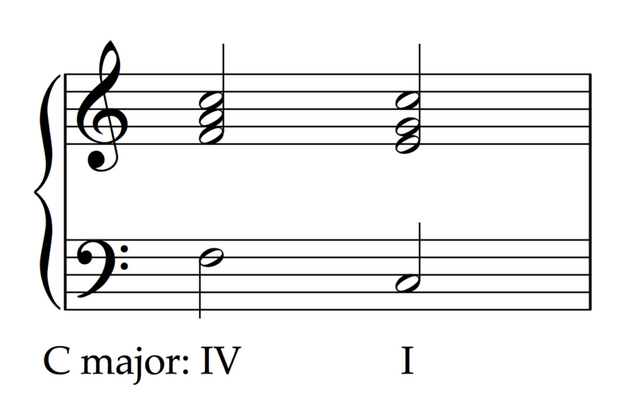
When writing in minor mode, we can use a specific type of half cadence called the Phrygian half cadence, which resolves a iv6 chord to a V chord. When writing these, the soprano and bass move by step in contrary motion. Since the bass moves down by a half step, the soprano must therefore move up by a step. Usually, we achieve this by doubling the root and having it move up by step to the root of the V chord.
On the left is a Phrygian half cadence, and on the right is a normal half cadence:
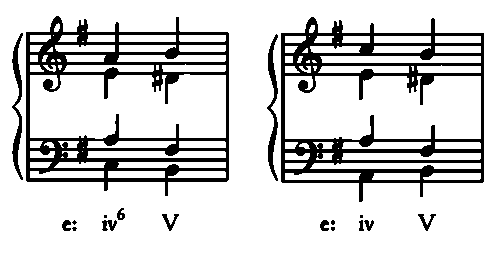
5.6: Cadential 6/4 Chords
Cadential 6/4 chords are used to embellish dominant chords before a cadence. Usually, we have a I 6/4-V-I progression, where the upper notes in the I 6/4 chord move down stepwise. For example, in C Major, a I 6/4 chord with notes G-C-E will have the upper notes move down so we have a G-B-D root position V chord.
Usually, the cadential 6/4 chord is written in a metrically stronger position than the dominant chord that follows it, and the upper voices of the 6/4 chord will move downward by step to reach the dominant chord. For example, if we have a cadential 6/4 chord in A Major, then the 6/4 chord will have the notes E-A-C, and then A and the C in the upper voices will move down to G and B respectively to spell the root position dominant chord E-G-B. Then, we will use our traditional voice leading rules to resolve the dominant chord to the I chord. The I chord will usually be written on a strong beat.
When we write cadential 6/4 chords, it is good practice to double the bass of the chord (not the root, like in traditional voice leading). This means that the fifth scale degree will show up twice in the 6/4 chord, which will emphasize its dominant function.
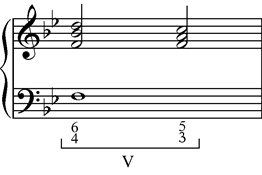
When moving from the cadential 6/4 chord to the dominant seventh chord, resolve the dominant tone in the upper voice of the cadential 6/4 chord downwards:
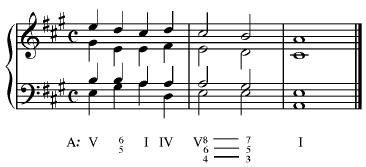
5.7: Additional 6/4 Chords
The pedal 6/4 chord, also called the neighboring 6/4 chord, occurs when the third and fifth of a root-position triad are embellished by upper neighbor tones while the bass line stays the same.
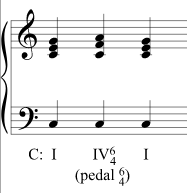
Passing 6/4 chords are chords where the bass line is moving up or down, usually by a third, and we fill in this skip with a 6/4 chord to fill in the bass. For example, if we have a I-V 6/4-I6 progression in C Major, then the bass line will be moving up stepwise as C-D-E, and the upper notes will move according to our voice leading rules.
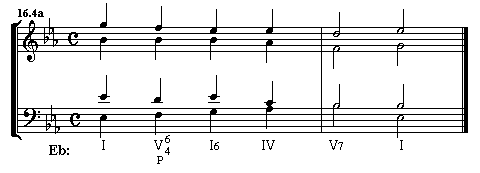
Arpeggiating 6/4 chords are used to embellish the same triad. So, we might have a I-I6-I 6/4 chord progression, where the bass note is changing. In this case, the 6/4 chord does have the same chord function as it would in the other inversions, but it is used to embellish the preceding triads rather than to add harmonic value in some way.
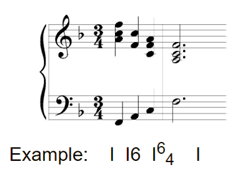
Sometimes, we will just have a I chord followed by a I 6/4 chord. This is quite common in waltzes, which are pieces written in 3/4 time. Waltzes usually have a strong downbeat and two lighter upbeats, so we might have a I chord on the downbeat followed by two I 6/4 chords on the upbeats.
Browse Study Guides By Unit
🎵Unit 1 – Music Fundamentals I (Pitch, Major Scales and Key Signatures, Rhythm, Meter, and Expressive Elements)
🎶Unit 2 – Music Fundamentals II (Minor Scales and Key Signatures, Melody, Timbre, and Texture)
🎻Unit 3 – Music Fundamentals III (Triads and Seventh Chords)
🎹Unit 4 – Harmony and Voice Leading I (Chord Function, Cadence, and Phrase)
🎸Unit 5: Harmony and Voice Leading II: Chord Progressions and Predominant Function
🎺Unit 6 – Harmony and Voice Leading III (Embellishments, Motives, and Melodic Devices)
🎤Unit 7 – Harmony and Voice Leading IV (Secondary Function)
🎷Unit 8 – Modes & Form
🧐Exam Skills
📚Study Tools

Fiveable
Resources
© 2025 Fiveable Inc. All rights reserved.